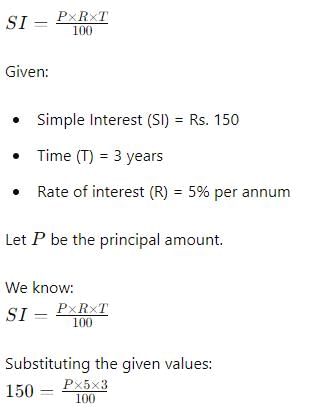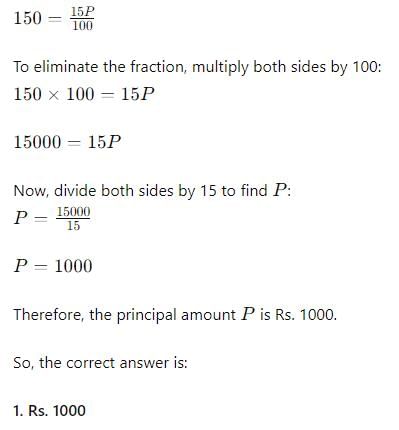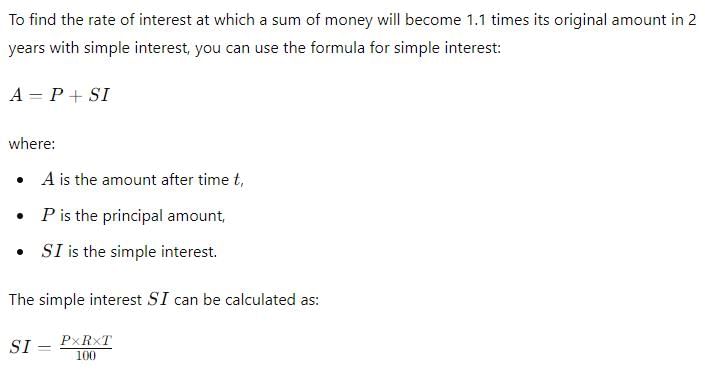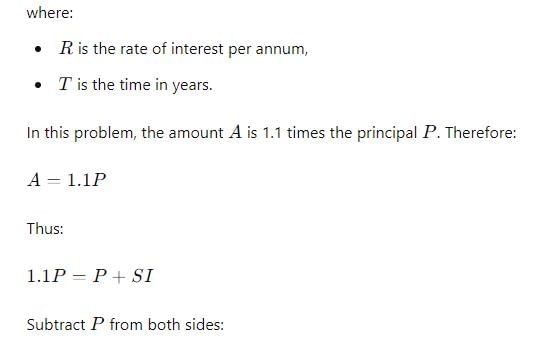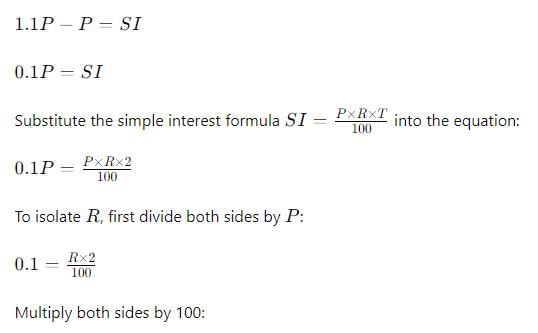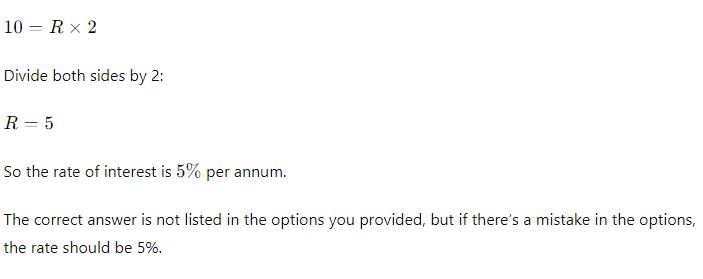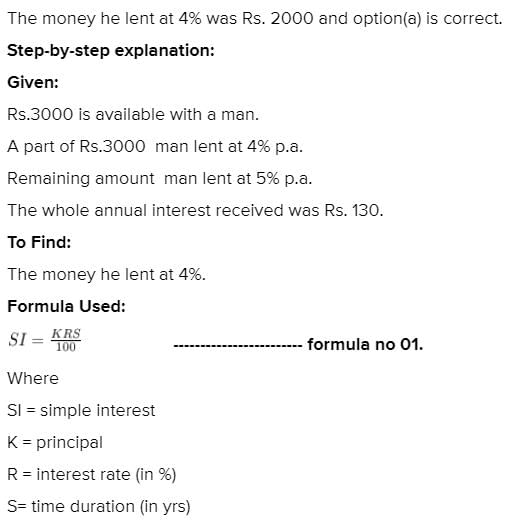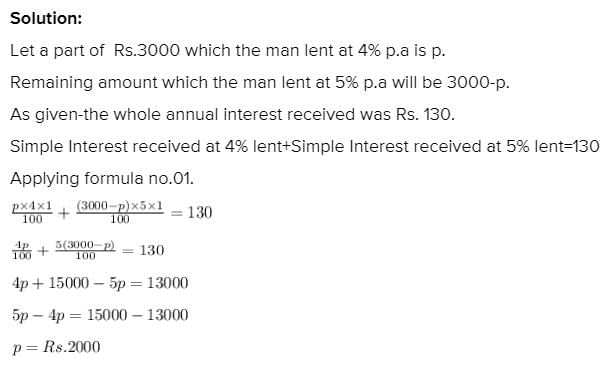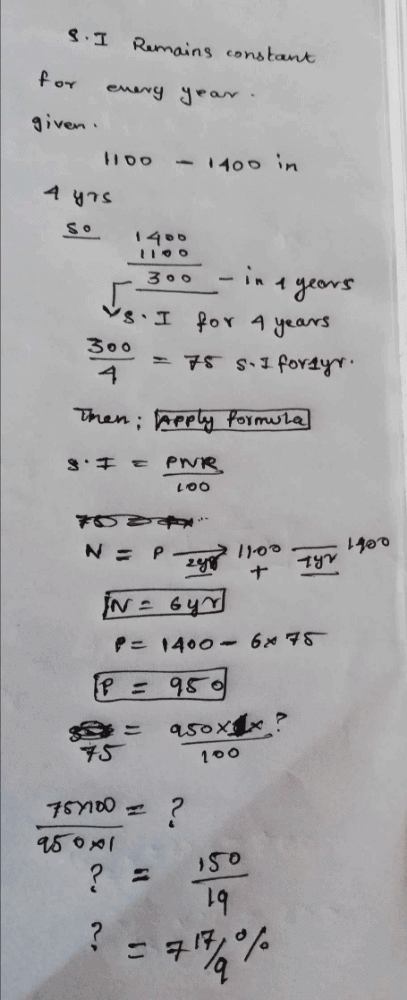All Exams >
CLAT >
Weekly Test for CLAT UG >
All Questions
All questions of Week 20 for CLAT Exam
Find the sum of money when increases 1/10 of itself every year amount to Rs. 600 in 5 years.- a)Rs. 380
- b)Rs. 280
- c)Rs. 480
- d)None
- e)All of the above
Correct answer is option 'D'. Can you explain this answer?
Find the sum of money when increases 1/10 of itself every year amount to Rs. 600 in 5 years.
a)
Rs. 380
b)
Rs. 280
c)
Rs. 480
d)
None
e)
All of the above

|
Ishani Rane answered |
This is an example of an exponential growth problem. Exponential growth can be modeled by the equation P = a(r)t, where a is the initial amount, t is the time that has passed, P is the amount after time t, and r is the rate of growth.
For your problem, t = 5 years and P = 600. The money increases by 1/10 = 10% each year, so each year, the amount of money is 110% of the previous year. That's a rate of growth of r = 1.1. So:
600 = a(1.1)5
600 = 1.61051a
372.55 = a
The sum was initially Rs. 372.55.
Which place is called as "Silicon Valley" of India? - a)Delhi
- b)Pune
- c)Bengaluru
- d)Hyderabad
Correct answer is option 'C'. Can you explain this answer?
Which place is called as "Silicon Valley" of India?
a)
Delhi
b)
Pune
c)
Bengaluru
d)
Hyderabad
|
|
Dia Mehta answered |
The Silicon Valley of India is a nickname of Bangalore. The name signifies Bangalore's status as a hub for information technology (IT) companies in India and is a comparative reference to the original Silicon Valley, based around Santa Clara Valley, California, USA.
Find the Compound Interest on Rs. 12500 at 8% per annum for 9 months compounded quarterly.
- a)Rs.1020
- b)Rs. 1428
- c)Rs. 510
- d)765.1
- e)All of the above
Correct answer is option 'D'. Can you explain this answer?
Find the Compound Interest on Rs. 12500 at 8% per annum for 9 months compounded quarterly.
a)
Rs.1020
b)
Rs. 1428
c)
Rs. 510
d)
765.1
e)
All of the above

|
EduRev CLAT answered |
The correct is D as
n=9 months
=3 quaterly
A=125000×(1+2/100)3^=125000×(1+2/100)^3
=125000×51/50×51/50×51/50=125000×51/50×51/50×51/50
=Rs.132651
CI=A−P
=132651−125000
=Rs.765.1
n=9 months
=3 quaterly
A=125000×(1+2/100)3^=125000×(1+2/100)^3
=125000×51/50×51/50×51/50=125000×51/50×51/50×51/50
=Rs.132651
CI=A−P
=132651−125000
=Rs.765.1
In what time Rs. 2600 amount to Rs. 3055 at the rate of 3 ½ % per annum.- a)2½ years
- b)5 years
- c)3 years
- d)None
- e)All of the above
Correct answer is option 'B'. Can you explain this answer?
In what time Rs. 2600 amount to Rs. 3055 at the rate of 3 ½ % per annum.
a)
2½ years
b)
5 years
c)
3 years
d)
None
e)
All of the above
|
|
Faizan Khan answered |
The correct option is B.
Principal amount=2600
Rate=3 1/2%pa=7/2
Time = T
SI=3055-2600=455
SI=PRT/100
455=2600×7×T/100×2,
T=5yrs.
Principal amount=2600
Rate=3 1/2%pa=7/2
Time = T
SI=3055-2600=455
SI=PRT/100
455=2600×7×T/100×2,
T=5yrs.
A man had Rs. 5800 a part of which he lent at 4% and rest at 6%. The whole annual interest received was Rs. 292. The money lent at 4% was ……?- a)Rs. 3000
- b)Rs. 2600
- c)Rs. 2700
- d)None
- e)All of the above
Correct answer is option 'D'. Can you explain this answer?
A man had Rs. 5800 a part of which he lent at 4% and rest at 6%. The whole annual interest received was Rs. 292. The money lent at 4% was ……?
a)
Rs. 3000
b)
Rs. 2600
c)
Rs. 2700
d)
None
e)
All of the above
|
|
Anaya Patel answered |
The correct option is D as Let the part lent at 4% be x then , rest will be (5800-x) .
(x*4*1)/100 + { (5800-x)*6*1 } / 100 = 292
4x/100 + { 34800 - 6x }/100 = 292
4x + 34800 - 6x = 29200
2x = 5600
x = 2800 so , d is correct option.
(x*4*1)/100 + { (5800-x)*6*1 } / 100 = 292
4x/100 + { 34800 - 6x }/100 = 292
4x + 34800 - 6x = 29200
2x = 5600
x = 2800 so , d is correct option.
.)In what time Rs. 540 at 5 percent per annum will produce the same Interest as Rs. 1800 in 5 years at 6 percent per annum.- a)10 years
- b)30 years
- c)25 years
- d)None
- e)All of the above
Correct answer is option 'D'. Can you explain this answer?
.)In what time Rs. 540 at 5 percent per annum will produce the same Interest as Rs. 1800 in 5 years at 6 percent per annum.
a)
10 years
b)
30 years
c)
25 years
d)
None
e)
All of the above

|
Bank Exams India answered |
Using the simple interest formula I = PRT, we set the interests equal: 540 * 0.05 * T = 1800 * 0.06 * 5. 27T = 540. T = 20 years. Since 20 isn't an option, the answer is D.
A lent 180 to B for 10 years and 200 to C for 2 years at Simple interest, the rate of interest being same in both the cases. He received Rs. 220 as total interest. Find the rate%.
- a)5%
- b)10%
- c)8%
- d)None
- e)All of the above
Correct answer is option 'B'. Can you explain this answer?
A lent 180 to B for 10 years and 200 to C for 2 years at Simple interest, the rate of interest being same in both the cases. He received Rs. 220 as total interest. Find the rate%.
a)
5%
b)
10%
c)
8%
d)
None
e)
All of the above

|
Melvin Joe answered |
T. S. I=220
S.I (B) +S. I(C) =(180*10*R+200*2*R)/100=220
2200R=22000
R=22000/2200
R=10%
S.I (B) +S. I(C) =(180*10*R+200*2*R)/100=220
2200R=22000
R=22000/2200
R=10%
Adam borrowed some money at the rate of 6% p.a. for the first two years, at the rate of 9% p.a. for the next three years and at the rate of 14% p.a.for the period beyond five years.1£ he pays a total interest of Rs. 11, 400 at the end of nine years how much money did he borrow?
- a)11,000
- b)12,000
- c)13,000
- d)14,000
- e)All of the above
Correct answer is option 'B'. Can you explain this answer?
Adam borrowed some money at the rate of 6% p.a. for the first two years, at the rate of 9% p.a. for the next three years and at the rate of 14% p.a.for the period beyond five years.1£ he pays a total interest of Rs. 11, 400 at the end of nine years how much money did he borrow?
a)
11,000
b)
12,000
c)
13,000
d)
14,000
e)
All of the above
|
|
Rhea Reddy answered |
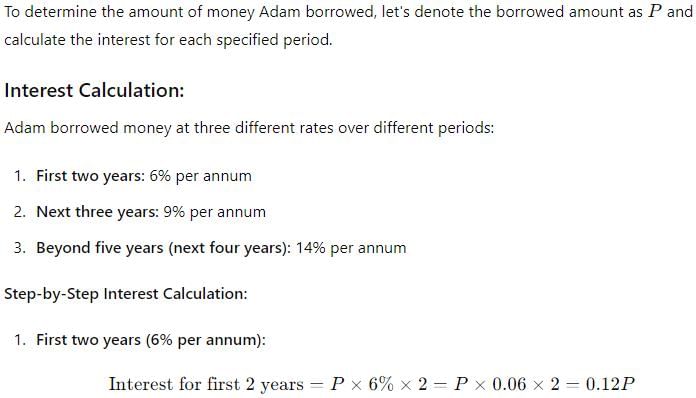
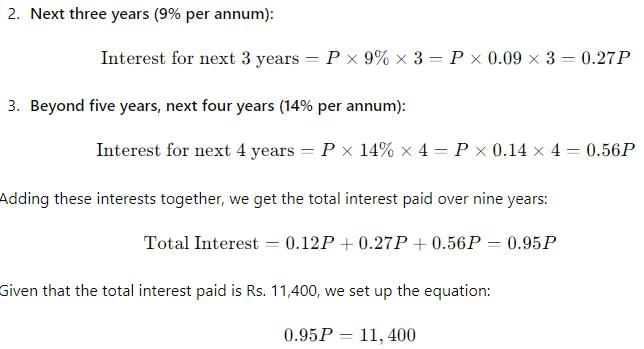

The Simple Interest on a certain sum of money for two years is Rs. 40 and the CI on same sum at same rate for same time is Rs. 40.50. Find the sum.- a)Rs. 1600
- b)Rs. 800
- c)Rs. 600
- d)None
- e)All of the above
Correct answer is option 'B'. Can you explain this answer?
The Simple Interest on a certain sum of money for two years is Rs. 40 and the CI on same sum at same rate for same time is Rs. 40.50. Find the sum.
a)
Rs. 1600
b)
Rs. 800
c)
Rs. 600
d)
None
e)
All of the above

|
Krishan Kumar answered |
1. Calculate Simple Interest (SI): SI formula: SI = P × R × T / 100. Given SI for two years is Rs.40. Thus, 40 = P × R × 2 / 100 => P × R = 2000 ...(1) 2. Calculate Compound Interest (CI): CI formula: A = P(1 + R / 100)2. CI for two years is Rs.40.50, so A = P + 40.50. Thus, CI = A - P = 40.50. Therefore, P[(1 + R / 100)2 - 1] = 40.50 ...(2) 3. Substitute R from equation (1) into equation (2): From (1), R = 2000 / P. Substitute into CI formula: P(1 + 20 / P)2 - P = 40.50. Simplify: P(1 + 40 / P + 400 / P2) - P = 40.50. This leads to 40 + 400 / P = 40.50. Therefore, 400 / P = 0.50 => P = 400 / 0.50 = 800. 4. Conclusion: The principal sum is Rs.800.
India is the largest producer of –- a)cotton
- b)rice
- c)mica
- d)tea
Correct answer is option 'C'. Can you explain this answer?
India is the largest producer of –
a)
cotton
b)
rice
c)
mica
d)
tea
|
|
Eshaan Kapoor answered |
India produces approximate 90 % of the world's mica. It is an indispensable component of the electrical industry. India accounts for 60 % of mica embarking in international trade.
A man buys a land and gives for it 20 times the annual rent. Find the rate of Interest he gets for his money.- a)10%
- b)3%
- c)4%
- d)None.
- e)All of the above
Correct answer is option 'D'. Can you explain this answer?
A man buys a land and gives for it 20 times the annual rent. Find the rate of Interest he gets for his money.
a)
10%
b)
3%
c)
4%
d)
None.
e)
All of the above
|
|
Nikita Singh answered |
Let annual rent is 1 Rs. so buys the land at 20 Rs. So by investing Rs.20 he is getting Rs.1 as interest. so on Rs.100 he gets Rs.5. So rate%=5%. Hence option D is the answer.
Find the rate of Simple Interest when a sum of money treble itself in 25 years.- a)4%
- b)10%
- c)8%
- d)None
- e)All of the above
Correct answer is option 'C'. Can you explain this answer?
Find the rate of Simple Interest when a sum of money treble itself in 25 years.
a)
4%
b)
10%
c)
8%
d)
None
e)
All of the above
|
|
Aarav Sharma answered |
Given, the sum of money trebles itself in 25 years.
Let the principal amount be P.
Formula:
Simple Interest = (P * R * T) / 100
where P is the principal amount, R is the rate of interest, and T is the time period.
Calculation:
After 25 years, the sum becomes 3P.
Using the formula of Simple Interest,
3P = P + (P * R * 25) / 100
2P = (P * R * 25) / 100
R = (2P * 100) / (P * 25)
R = 8%
Therefore, the rate of Simple Interest is 8%. Hence, option C is the correct answer.
Let the principal amount be P.
Formula:
Simple Interest = (P * R * T) / 100
where P is the principal amount, R is the rate of interest, and T is the time period.
Calculation:
After 25 years, the sum becomes 3P.
Using the formula of Simple Interest,
3P = P + (P * R * 25) / 100
2P = (P * R * 25) / 100
R = (2P * 100) / (P * 25)
R = 8%
Therefore, the rate of Simple Interest is 8%. Hence, option C is the correct answer.
Which part of the Himalayas has the maximum stretch from east to West? - a)Kumaun Himalayas
- b)Assam Himalayas
- c)Punjab Himalayas
- d)Nepal Himalayas
Correct answer is option 'D'. Can you explain this answer?
Which part of the Himalayas has the maximum stretch from east to West?
a)
Kumaun Himalayas
b)
Assam Himalayas
c)
Punjab Himalayas
d)
Nepal Himalayas
|
|
Monika joshi answered |
The maximum stretch of the Himalayas from east to west is found in the Nepal Himalayas. Let's break down the answer into headings and HTML bullet points:
I. Overview of the Himalayas
- The Himalayas is a mountain range in Asia that spans across several countries including India, Nepal, Bhutan, Tibet, and Pakistan.
- It is the highest mountain range in the world and is home to several peaks including Mount Everest, K2, and Kangchenjunga.
II. Different Parts of the Himalayas
- The Himalayas is divided into several parts based on its location and features.
- Some of the major parts include the Kumaun Himalayas, Assam Himalayas, Punjab Himalayas, Nepal Himalayas, and Karakoram range.
III. Maximum Stretch from East to West
- Among the different parts of the Himalayas, the Nepal Himalayas has the maximum stretch from east to west.
- It extends over a distance of more than 800 km from the easternmost point of Nepal to the westernmost point of Nepal.
- This stretch includes several peaks and ranges including the Annapurna range, Langtang range, and Mount Everest.
In conclusion, the Nepal Himalayas has the maximum stretch from east to west among the different parts of the Himalayas. It covers a distance of more than 800 km and includes several peaks and ranges.
I. Overview of the Himalayas
- The Himalayas is a mountain range in Asia that spans across several countries including India, Nepal, Bhutan, Tibet, and Pakistan.
- It is the highest mountain range in the world and is home to several peaks including Mount Everest, K2, and Kangchenjunga.
II. Different Parts of the Himalayas
- The Himalayas is divided into several parts based on its location and features.
- Some of the major parts include the Kumaun Himalayas, Assam Himalayas, Punjab Himalayas, Nepal Himalayas, and Karakoram range.
III. Maximum Stretch from East to West
- Among the different parts of the Himalayas, the Nepal Himalayas has the maximum stretch from east to west.
- It extends over a distance of more than 800 km from the easternmost point of Nepal to the westernmost point of Nepal.
- This stretch includes several peaks and ranges including the Annapurna range, Langtang range, and Mount Everest.
In conclusion, the Nepal Himalayas has the maximum stretch from east to west among the different parts of the Himalayas. It covers a distance of more than 800 km and includes several peaks and ranges.
'Yellow Revolution' is associated with the production of –- a)Poultry
- b)Gold
- c)Sunflower
- d)Oil seeds
Correct answer is option 'D'. Can you explain this answer?
'Yellow Revolution' is associated with the production of –
a)
Poultry
b)
Gold
c)
Sunflower
d)
Oil seeds
|
|
Dia Mehta answered |
Yellow Revolution pertains to oilseeds. The growth, development and adoption of new varieties of oilseeds and complementary technologies nearly doubled oil-seeds production from 12.6 mt in 1987-88 to 24.4 mt in 1996-97, catalyzed by the Technology Mission on Oilseeds, brought about the Yellow Revolution. The oilseeds production scenario in India has witnessed a dramatic turn
Identify the sentence that incorrectly uses the past perfect continuous tense.- a)Before the rain started, the children had been playing outside.
- b)He had been working in the office since morning.
- c)They have been waiting for the bus when it finally arrived.
- d)She had been studying for the exam for several hours.
Correct answer is option 'C'. Can you explain this answer?
a)
Before the rain started, the children had been playing outside.
b)
He had been working in the office since morning.
c)
They have been waiting for the bus when it finally arrived.
d)
She had been studying for the exam for several hours.
|
|
Ishaan Roy answered |
Incorrect Sentence:
C) They have been waiting for the bus when it finally arrived.
Explanation:
The past perfect continuous tense is used to describe an action that started in the past, continued up until another point in the past, and may still have some relevance in the present. It is formed by using the auxiliary verb "had been" followed by the present participle of the main verb (-ing form).
In the given sentence, "They have been waiting for the bus when it finally arrived," the use of the present perfect continuous tense is incorrect. Here's why:
1. Present Perfect Continuous Tense:
The present perfect continuous tense is used to describe an action that started in the past, continued up until the present moment, and may still be ongoing. It is formed by using the auxiliary verb "have been" followed by the present participle of the main verb (-ing form).
Example: They have been waiting for the bus for an hour. (Correct use of present perfect continuous tense)
2. Past Perfect Continuous Tense:
The past perfect continuous tense is used to describe an action that started in the past, continued up until another point in the past, and may still have some relevance in the present. It is formed by using the auxiliary verb "had been" followed by the present participle of the main verb (-ing form).
Example: They had been waiting for the bus for an hour before it finally arrived. (Correct use of past perfect continuous tense)
3. Incorrect Use:
In sentence C, the present perfect continuous tense "have been waiting" is used instead of the past perfect continuous tense "had been waiting." This creates a grammatical inconsistency because the action of waiting for the bus should be completed before the bus finally arrived.
Therefore, the correct sentence should be: They had been waiting for the bus when it finally arrived.
C) They have been waiting for the bus when it finally arrived.
Explanation:
The past perfect continuous tense is used to describe an action that started in the past, continued up until another point in the past, and may still have some relevance in the present. It is formed by using the auxiliary verb "had been" followed by the present participle of the main verb (-ing form).
In the given sentence, "They have been waiting for the bus when it finally arrived," the use of the present perfect continuous tense is incorrect. Here's why:
1. Present Perfect Continuous Tense:
The present perfect continuous tense is used to describe an action that started in the past, continued up until the present moment, and may still be ongoing. It is formed by using the auxiliary verb "have been" followed by the present participle of the main verb (-ing form).
Example: They have been waiting for the bus for an hour. (Correct use of present perfect continuous tense)
2. Past Perfect Continuous Tense:
The past perfect continuous tense is used to describe an action that started in the past, continued up until another point in the past, and may still have some relevance in the present. It is formed by using the auxiliary verb "had been" followed by the present participle of the main verb (-ing form).
Example: They had been waiting for the bus for an hour before it finally arrived. (Correct use of past perfect continuous tense)
3. Incorrect Use:
In sentence C, the present perfect continuous tense "have been waiting" is used instead of the past perfect continuous tense "had been waiting." This creates a grammatical inconsistency because the action of waiting for the bus should be completed before the bus finally arrived.
Therefore, the correct sentence should be: They had been waiting for the bus when it finally arrived.
Sivasamudra is an island formed by the river –- a)Ganga
- b)Godavari
- c)Krishna
- d)Cauvery
Correct answer is option 'D'. Can you explain this answer?
Sivasamudra is an island formed by the river –
a)
Ganga
b)
Godavari
c)
Krishna
d)
Cauvery
|
|
Aryan Khanna answered |
Shivanasamudra is a small town in the Mandya District of the state of Karnataka, India. It is situated on the banks of the river Kaveri, which forms here the boundary to the Chamarajanagar District, and is the location of one of the first Hydro-electric Power stations in Asia, which was set up in the year 1902.
In which part of India, canal irrigation system is the most common? - a)Tamil Nadu
- b)Maharashtra
- c)Sikkim
- d)Uttar Pradesh
Correct answer is option 'D'. Can you explain this answer?
In which part of India, canal irrigation system is the most common?
a)
Tamil Nadu
b)
Maharashtra
c)
Sikkim
d)
Uttar Pradesh
|
|
Eshaan Kapoor answered |
Canal is the second largest source of irrigation providing water to 29.24 percent of the net area under irrigation. The country has one of the world's largest canal systems stretching over more than one lalch kilometres. Canal irrigation is widely practiced in the SutlejGanga plain. Uttar Pradesh, Punjab, Haryana, Bihar and Rajasthan have a number of such canals. In the Peninsular region canals are mostly found in the lower valleys and deltas of large rivers.
Nasik is situated on the bank of the river –- a)Mahanadi
- b)Tapti
- c)Krishna
- d)Godavari
Correct answer is option 'D'. Can you explain this answer?
Nasik is situated on the bank of the river –
a)
Mahanadi
b)
Tapti
c)
Krishna
d)
Godavari
|
|
Aryan Khanna answered |
Nasik, also known as the Wine Capital of India, or as India's Napa Valley, is located in Maharashtra in the Western Ghats, on the western edge of the Deccan peninsula on the banks of the Godavari.
Where is the Forest Research Institute of India located? - a)Dehradun
- b)Delhi
- c)Lucknow
- d)Bhopal
Correct answer is option 'A'. Can you explain this answer?
Where is the Forest Research Institute of India located?
a)
Dehradun
b)
Delhi
c)
Lucknow
d)
Bhopal
|
|
Eshaan Kapoor answered |
The Forest Research Institute (FRI) is located at Dehradun in Uttarakhand. Founded as the Imperial Forest Research Institute in 1906, it is one of the oldest institutions of its kind. It is an institute of the Indian Council of Forestry Research and Education and is a premier institution in the field of forestry research in India.
The largest irrigated area in India is occupied by –- a)Sugarcane
- b)Rice
- c)Cotton
- d)Wheat
Correct answer is option 'B'. Can you explain this answer?
The largest irrigated area in India is occupied by –
a)
Sugarcane
b)
Rice
c)
Cotton
d)
Wheat
|
|
Aryan Khanna answered |
The total area under irrigated rice is about 22.00 million hectares, which accounts about 49.5 per cent of the total area under rice crop in the country. Rice is grown under irrigated conditions in the states of Punjab, Haryana, Uttar Pradesh, Jammu & Kashmir, Andhra Pradesh, Tamil Nadu, Sikkim, Karnataka, Himachal Pradesh and Gujarat. In these states, rice is grown under irrigated conditions more than 5090%.
The percentage of India's forested land out of total land is –- a)30%
- b)25%
- c)less than 25%
- d)33%
Correct answer is option 'C'. Can you explain this answer?
The percentage of India's forested land out of total land is –
a)
30%
b)
25%
c)
less than 25%
d)
33%
|
|
Dia Mehta answered |
According to the India State of Forest Report (ISFR) 2015, the total forest cover as percentage of geographical area is 21.34 percent. Total tree cover as percentage of geographical area is 2.82 per cent. The total forest and tree cover is 79.42 million hectares, which is 24.16 percent of the total geographical area.
Choose the correct form of the verb to complete the sentence: "By the time the teacher arrived, the students _____ quietly for her for more than thirty minutes."- a)had been waiting
- b)has been waiting
- c)were waiting
- d)have been waiting
Correct answer is option 'A'. Can you explain this answer?
a)
had been waiting
b)
has been waiting
c)
were waiting
d)
have been waiting
|
|
Nilesh Banerjee answered |
Understanding the Correct Verb Form
In the sentence "By the time the teacher arrived, the students _____ quietly for her for more than thirty minutes," the correct verb form to use is "had been waiting."
Reasons for Choosing "had been waiting"
- Past Perfect Continuous Tense:
- The phrase "had been waiting" indicates an action that started in the past and continued up until another point in the past (the teacher's arrival).
- It emphasizes the duration of the waiting period (more than thirty minutes).
- Contextual Clarity:
- The use of "had been" clearly shows that the students' waiting was completed before the teacher arrived.
- This tense provides a timeline that is essential for understanding the sequence of events.
Other Options Explained
- b) has been waiting:
- This form is present perfect continuous, used for actions that started in the past and continue to the present. It does not fit the context because the teacher has already arrived.
- c) were waiting:
- This is past continuous tense, which describes an action occurring at a specific moment in the past. It lacks the aspect of duration emphasized in the sentence.
- d) have been waiting:
- This is present perfect continuous, similarly inappropriate as it implies that the waiting continues into the present.
Conclusion
Using "had been waiting" is essential to convey the correct timeline and duration of the students’ activity before the teacher's arrival, aligning perfectly with the context provided.
In the sentence "By the time the teacher arrived, the students _____ quietly for her for more than thirty minutes," the correct verb form to use is "had been waiting."
Reasons for Choosing "had been waiting"
- Past Perfect Continuous Tense:
- The phrase "had been waiting" indicates an action that started in the past and continued up until another point in the past (the teacher's arrival).
- It emphasizes the duration of the waiting period (more than thirty minutes).
- Contextual Clarity:
- The use of "had been" clearly shows that the students' waiting was completed before the teacher arrived.
- This tense provides a timeline that is essential for understanding the sequence of events.
Other Options Explained
- b) has been waiting:
- This form is present perfect continuous, used for actions that started in the past and continue to the present. It does not fit the context because the teacher has already arrived.
- c) were waiting:
- This is past continuous tense, which describes an action occurring at a specific moment in the past. It lacks the aspect of duration emphasized in the sentence.
- d) have been waiting:
- This is present perfect continuous, similarly inappropriate as it implies that the waiting continues into the present.
Conclusion
Using "had been waiting" is essential to convey the correct timeline and duration of the students’ activity before the teacher's arrival, aligning perfectly with the context provided.
In what way can understanding paradoxes enhance critical thinking?- a) It encourages acceptance of contradictions
- b) It promotes a rigid way of thinking
- c) It simplifies complex ideas
- d) It helps in finding a resolution that satisfies both sides
Correct answer is option 'D'. Can you explain this answer?
In what way can understanding paradoxes enhance critical thinking?
a)
It encourages acceptance of contradictions
b)
It promotes a rigid way of thinking
c)
It simplifies complex ideas
d)
It helps in finding a resolution that satisfies both sides
|
|
Kalyan Mehta answered |
Understanding Paradoxes and Critical Thinking
Understanding paradoxes is essential for enhancing critical thinking skills, as it encourages individuals to explore complex ideas and reconcile seemingly contradictory viewpoints.
Promoting Resolution
- Paradoxes often present conflicting ideas that challenge our usual ways of thinking.
- By grappling with these contradictions, individuals are pushed to think more deeply and creatively.
- This process can lead to innovative solutions that satisfy both sides of the paradox, fostering a more nuanced understanding of the issue at hand.
Encouraging Open-Mindedness
- Engaging with paradoxes encourages open-mindedness, allowing individuals to consider perspectives they might typically dismiss.
- This shift in thinking promotes flexibility, as one learns to navigate gray areas rather than adhering strictly to black-and-white reasoning.
Enhancing Problem-Solving Skills
- When faced with a paradox, critical thinkers are prompted to analyze the problem from multiple angles.
- This multifaceted analysis often uncovers underlying assumptions and biases, leading to more comprehensive and effective solutions.
Real-World Applications
- In real-life situations, paradoxes can be found in ethical dilemmas, policy decisions, and interpersonal relationships.
- Understanding how to resolve these contradictions can lead to better decision-making and conflict resolution.
In summary, engaging with paradoxes enriches critical thinking by promoting resolution, encouraging open-mindedness, enhancing problem-solving skills, and applying these lessons to real-world challenges.
Understanding paradoxes is essential for enhancing critical thinking skills, as it encourages individuals to explore complex ideas and reconcile seemingly contradictory viewpoints.
Promoting Resolution
- Paradoxes often present conflicting ideas that challenge our usual ways of thinking.
- By grappling with these contradictions, individuals are pushed to think more deeply and creatively.
- This process can lead to innovative solutions that satisfy both sides of the paradox, fostering a more nuanced understanding of the issue at hand.
Encouraging Open-Mindedness
- Engaging with paradoxes encourages open-mindedness, allowing individuals to consider perspectives they might typically dismiss.
- This shift in thinking promotes flexibility, as one learns to navigate gray areas rather than adhering strictly to black-and-white reasoning.
Enhancing Problem-Solving Skills
- When faced with a paradox, critical thinkers are prompted to analyze the problem from multiple angles.
- This multifaceted analysis often uncovers underlying assumptions and biases, leading to more comprehensive and effective solutions.
Real-World Applications
- In real-life situations, paradoxes can be found in ethical dilemmas, policy decisions, and interpersonal relationships.
- Understanding how to resolve these contradictions can lead to better decision-making and conflict resolution.
In summary, engaging with paradoxes enriches critical thinking by promoting resolution, encouraging open-mindedness, enhancing problem-solving skills, and applying these lessons to real-world challenges.
A certain sum amounts to Rs. 1400 in 2 years and Rs. 1600 in 3 years. Find the rate of simple interest and the sum(principal)?- a)15%, Rs. 1100
- b)20%, Rs. 1000
- c)17%, Rs. 1400
- d)20%, Rs. 1100
- e)22%, Rs. 900
Correct answer is option 'B'. Can you explain this answer?
A certain sum amounts to Rs. 1400 in 2 years and Rs. 1600 in 3 years. Find the rate of simple interest and the sum(principal)?
a)
15%, Rs. 1100
b)
20%, Rs. 1000
c)
17%, Rs. 1400
d)
20%, Rs. 1100
e)
22%, Rs. 900
|
|
Sagar Sharma answered |
Given:
- Sum amounts to Rs. 1400 in 2 years
- Sum amounts to Rs. 1600 in 3 years
To find:
- Rate of simple interest
- Principal sum
Let's assume the principal sum as P and the rate of interest as R.
Formula:
Simple Interest (SI) = (P * R * T) / 100
Where:
- P is the principal sum
- R is the rate of interest
- T is the time period in years
Solution:
We have two equations based on the given information:
1) P + (P * R * 2) / 100 = 1400 (Equation 1)
2) P + (P * R * 3) / 100 = 1600 (Equation 2)
Simplifying Equation 1:
100P + 2PR = 140000
100P = 140000 - 2PR
P = (140000 - 2PR) / 100
P = 1400 - 2PR (Equation 3)
Simplifying Equation 2:
100P + 3PR = 160000
100P = 160000 - 3PR
P = (160000 - 3PR) / 100
P = 1600 - 3PR (Equation 4)
Subtracting Equation 4 from Equation 3:
P - P = (1400 - 2PR) - (1600 - 3PR)
0 = 1400 - 1600 + 2PR - 3PR
0 = -200 - PR
PR = -200 (Equation 5)
Since the rate of interest cannot be negative, we can ignore the negative sign in Equation 5.
Now substitute the value of PR in Equation 3:
P = 1400 - 2(-200)
P = 1400 + 400
P = 1800
Therefore, the principal sum is Rs. 1800.
Substituting the values of P and R in Equation 1 to find the rate of interest:
1800 + (1800 * R * 2) / 100 = 1400
1800 + 36R = 1400
36R = 1400 - 1800
36R = -400
R = -400 / 36
R = -11.11
Again, we ignore the negative sign as the rate of interest cannot be negative.
Therefore, the rate of simple interest is 11.11%.
Hence, the correct answer is option B) 20% and Rs. 1000.
- Sum amounts to Rs. 1400 in 2 years
- Sum amounts to Rs. 1600 in 3 years
To find:
- Rate of simple interest
- Principal sum
Let's assume the principal sum as P and the rate of interest as R.
Formula:
Simple Interest (SI) = (P * R * T) / 100
Where:
- P is the principal sum
- R is the rate of interest
- T is the time period in years
Solution:
We have two equations based on the given information:
1) P + (P * R * 2) / 100 = 1400 (Equation 1)
2) P + (P * R * 3) / 100 = 1600 (Equation 2)
Simplifying Equation 1:
100P + 2PR = 140000
100P = 140000 - 2PR
P = (140000 - 2PR) / 100
P = 1400 - 2PR (Equation 3)
Simplifying Equation 2:
100P + 3PR = 160000
100P = 160000 - 3PR
P = (160000 - 3PR) / 100
P = 1600 - 3PR (Equation 4)
Subtracting Equation 4 from Equation 3:
P - P = (1400 - 2PR) - (1600 - 3PR)
0 = 1400 - 1600 + 2PR - 3PR
0 = -200 - PR
PR = -200 (Equation 5)
Since the rate of interest cannot be negative, we can ignore the negative sign in Equation 5.
Now substitute the value of PR in Equation 3:
P = 1400 - 2(-200)
P = 1400 + 400
P = 1800
Therefore, the principal sum is Rs. 1800.
Substituting the values of P and R in Equation 1 to find the rate of interest:
1800 + (1800 * R * 2) / 100 = 1400
1800 + 36R = 1400
36R = 1400 - 1800
36R = -400
R = -400 / 36
R = -11.11
Again, we ignore the negative sign as the rate of interest cannot be negative.
Therefore, the rate of simple interest is 11.11%.
Hence, the correct answer is option B) 20% and Rs. 1000.
Complete the sentence: "She _____ English for three years before she moved to London."- a)has been studying
- b)had been studying
- c)studied
- d)was studying
Correct answer is option 'B'. Can you explain this answer?
a)
has been studying
b)
had been studying
c)
studied
d)
was studying

|
EduRev SSC CGL answered |
The correct answer is Option B: "had been studying." This sentence requires the past perfect continuous tense to express that she had been continuously studying English for three years before a specific point in the past (her moving to London). The other options do not correctly indicate the continuity of the action up to a point in the past.
In what time will Rs. 72 become Rs. 81 at 25/4% per annum simple interest?- a)2 years
- b)3 years
- c)2 years 6 months
- d)Can’t determine
- e)None of these
Correct answer is option 'B'. Can you explain this answer?
In what time will Rs. 72 become Rs. 81 at 25/4% per annum simple interest?
a)
2 years
b)
3 years
c)
2 years 6 months
d)
Can’t determine
e)
None of these

|
Jay Mehra answered |
Interest = Rs. (81-72) = Rs. 9
Let the time be t years.
9 = (72×25×t)/(4×100)
t = (9×400)/(72×25)=2 years
Let the time be t years.
9 = (72×25×t)/(4×100)
t = (9×400)/(72×25)=2 years
The simple Interest on a certain sum of money at the rate of 4% p.a. for 5 years is Rs. 1680. At what rate of interest the same amount of interest can be received on the same sum after 4 years ?- a)5%
- b)6%
- c)7%
- d)8%
Correct answer is option 'A'. Can you explain this answer?
The simple Interest on a certain sum of money at the rate of 4% p.a. for 5 years is Rs. 1680. At what rate of interest the same amount of interest can be received on the same sum after 4 years ?
a)
5%
b)
6%
c)
7%
d)
8%

|
Anu Mehta answered |
5%
S.I. = 1680, R = 4% T = 5 years
Principal = (100 *1680)/ (5*4) = 8400
So P = 8400
Rate = (100 *1680)/ (8400 * 4) = 5%
S.I. = 1680, R = 4% T = 5 years
Principal = (100 *1680)/ (5*4) = 8400
So P = 8400
Rate = (100 *1680)/ (8400 * 4) = 5%
Which state of India has made rain water harvesting compulsory for all houses? - a)Haryana
- b)Maharashtra
- c)Tamil Nadu
- d)Punjab
Correct answer is option 'C'. Can you explain this answer?
Which state of India has made rain water harvesting compulsory for all houses?
a)
Haryana
b)
Maharashtra
c)
Tamil Nadu
d)
Punjab
|
|
Anushka mehta answered |
Tamil Nadu has made rainwater harvesting compulsory for all houses in the state. This move was initiated in response to the severe water scarcity and drought conditions faced by the state. The government of Tamil Nadu recognized the importance of conserving water and implemented this mandatory policy to ensure sustainable water management.
The state government of Tamil Nadu enacted the Tamil Nadu Combined Development and Building Rules (TNCDBR) in 2003, which made it mandatory for all buildings to have a rainwater harvesting system. This law applies to all types of residential, commercial, and industrial buildings. The objective behind this regulation is to capture and store rainwater, which can then be used for various purposes such as domestic use, irrigation, and recharging groundwater.
Key Points:
1. The Tamil Nadu Combined Development and Building Rules (TNCDBR) enacted in 2003 made rainwater harvesting compulsory for all buildings in the state.
2. The law applies to residential, commercial, and industrial buildings.
3. The aim is to capture and store rainwater to address water scarcity and drought conditions.
4. Rainwater harvesting helps in sustainable water management and conservation.
5. The stored rainwater can be used for domestic purposes, irrigation, and recharging groundwater.
6. The policy is a response to the severe water scarcity and drought conditions faced by Tamil Nadu.
7. Tamil Nadu has been actively promoting rainwater harvesting as a means to address water scarcity.
8. The state government provides incentives and subsidies to encourage the adoption of rainwater harvesting systems.
9. The success of this policy has led to a significant increase in the number of buildings with rainwater harvesting systems in Tamil Nadu.
Overall, the mandatory implementation of rainwater harvesting in Tamil Nadu has been a significant step towards water conservation and sustainable water management. It has helped in addressing the water scarcity issues faced by the state and has encouraged individuals and organizations to actively participate in rainwater harvesting initiatives.
The state government of Tamil Nadu enacted the Tamil Nadu Combined Development and Building Rules (TNCDBR) in 2003, which made it mandatory for all buildings to have a rainwater harvesting system. This law applies to all types of residential, commercial, and industrial buildings. The objective behind this regulation is to capture and store rainwater, which can then be used for various purposes such as domestic use, irrigation, and recharging groundwater.
Key Points:
1. The Tamil Nadu Combined Development and Building Rules (TNCDBR) enacted in 2003 made rainwater harvesting compulsory for all buildings in the state.
2. The law applies to residential, commercial, and industrial buildings.
3. The aim is to capture and store rainwater to address water scarcity and drought conditions.
4. Rainwater harvesting helps in sustainable water management and conservation.
5. The stored rainwater can be used for domestic purposes, irrigation, and recharging groundwater.
6. The policy is a response to the severe water scarcity and drought conditions faced by Tamil Nadu.
7. Tamil Nadu has been actively promoting rainwater harvesting as a means to address water scarcity.
8. The state government provides incentives and subsidies to encourage the adoption of rainwater harvesting systems.
9. The success of this policy has led to a significant increase in the number of buildings with rainwater harvesting systems in Tamil Nadu.
Overall, the mandatory implementation of rainwater harvesting in Tamil Nadu has been a significant step towards water conservation and sustainable water management. It has helped in addressing the water scarcity issues faced by the state and has encouraged individuals and organizations to actively participate in rainwater harvesting initiatives.
Identify the sentence that correctly uses the past perfect continuous tense.- a)He had been studying when the power went off.
- b)She is reading a book since morning.
- c)They will be playing football tomorrow.
- d)We were going to the market.
Correct answer is option 'A'. Can you explain this answer?
a)
He had been studying when the power went off.
b)
She is reading a book since morning.
c)
They will be playing football tomorrow.
d)
We were going to the market.

|
G.K Academy answered |
Option A, "He had been studying when the power went off," is the correct answer. This sentence correctly uses the past perfect continuous tense, indicating an action (studying) that was ongoing in the past before another past event (power going off). The other options use different tenses: present continuous (Option B), future continuous (Option C), and past continuous (Option D).
Fill in the blank: "By the time the concert started, the band _____ for months."- a)practiced
- b)had been practicing
- c)has been practicing
- d)were practicing
Correct answer is option 'B'. Can you explain this answer?
a)
practiced
b)
had been practicing
c)
has been practicing
d)
were practicing

|
Iq Funda answered |
Option B: "had been practicing" is correct. This sentence requires the past perfect continuous tense to convey that the band had been continuously practicing for months before the concert started. The other options do not appropriately express the continuity of the action up to a past event.
Which of the following states in known as the traditional region for Tank Irrigation? - a)Assam
- b)Gujarat
- c)Tamil Nadu
- d)Orrisa
Correct answer is option 'C'. Can you explain this answer?
Which of the following states in known as the traditional region for Tank Irrigation?
a)
Assam
b)
Gujarat
c)
Tamil Nadu
d)
Orrisa
|
|
Faizan Khan answered |
The Trans-Himalayan Rivers originate beyond the Great Himalayas. These are the Indus. the Sutlej and the Brahmaputra rivers. The Trans Himalayan Indus River rises near the Mansarovar Lake on the Tibetan plateau. It enters the Himalayas in southeastern Ladakh near its confluence with the River Gurtang at an elevation of 4,200 m.
The originating point of river godavri is –- a)Nasik
- b)Pune
- c)Mumbai
- d)Sholapur
Correct answer is option 'A'. Can you explain this answer?
The originating point of river godavri is –
a)
Nasik
b)
Pune
c)
Mumbai
d)
Sholapur
|
|
Faizan Khan answered |
The Godavari is a river in the south-central India. It originates in the Western Ghats Trimbakeshwar, in the Nasik Subdivision of the western state of Maharashtra and flows through the modern state of Andhra Pradesh before reaching the Bay of Bengal.
Sardar Sarovar dam is being built on the river –- a)Tapti
- b)Mahi
- c)Chambal
- d)Narmada
Correct answer is option 'D'. Can you explain this answer?
Sardar Sarovar dam is being built on the river –
a)
Tapti
b)
Mahi
c)
Chambal
d)
Narmada
|
|
Aryan Khanna answered |
The Sardar Sarovar Dam is a gravity dam on the Narmada River near Navagam, Gujarat, India. It is the largest dam and part of the Narmada Valley Project, a large hydraulic engineering project involving the construction of a series of large irrigation and hydro-electric multi-purpose dams on the Narmada River. The project took form in 1979 as part of a development scheme to increase irrigation and produce hydroelectricity. It is the 30th largest dams planned on river Narmada. Sardar Sarovar Dam (SSD) is the largest structure to be built.
Green Revolution in India has so far been most successful in case of–
- a)sugarcane
- b)coarse grains
- c)wheat
- d)pulses
Correct answer is option 'C'. Can you explain this answer?
Green Revolution in India has so far been most successful in case of–
a)
sugarcane
b)
coarse grains
c)
wheat
d)
pulses
|
|
Eshaan Kapoor answered |
The Correct Option is C : wheat
Green Revolution in India:
- The Green Revolution refers to a series of research, development, and technology transfer initiatives that took place between the 1940s and the late 1970s.
- Its main objective was to increase agricultural production, particularly in developing countries like India, to ensure food security and alleviate hunger and poverty.
- The Green Revolution introduced high-yielding varieties of seeds, modern farming techniques, and the use of chemical fertilizers and pesticides.
Success in case of Wheat:
- The Green Revolution has been most successful in the case of wheat in India.
- The Green Revolution refers to a series of research, development, and technology transfer initiatives that took place between the 1940s and the late 1970s.
- Its main objective was to increase agricultural production, particularly in developing countries like India, to ensure food security and alleviate hunger and poverty.
- The Green Revolution introduced high-yielding varieties of seeds, modern farming techniques, and the use of chemical fertilizers and pesticides.
Success in case of Wheat:
- The Green Revolution has been most successful in the case of wheat in India.
Some reasons for this success include:
1. Introduction of high-yielding varieties: Scientists developed high-yielding varieties of wheat seeds that were more responsive to chemical fertilizers and had a higher resistance to diseases. These varieties significantly increased wheat production.
2. Irrigation facilities: The government focused on improving irrigation facilities to ensure a consistent supply of water to wheat fields. This enabled farmers to grow wheat on a larger scale and increase production.
3. Use of chemical fertilizers and pesticides: The Green Revolution promoted the use of chemical fertilizers and pesticides to increase crop yields. This helped in boosting wheat production by providing the essential nutrients needed for growth and protecting the crop from pests and diseases.
4. Support from the government: The Indian government provided various incentives to farmers, such as subsidized fertilizers, pesticides, and electricity for irrigation, which encouraged them to adopt modern agricultural practices and increase wheat production.
5. Agricultural research and extension services: The government established research institutes and extension services to help educate farmers about new agricultural practices and technologies. This played a crucial role in the widespread adoption of high-yielding varieties and other modern farming techniques in wheat cultivation.
1. Introduction of high-yielding varieties: Scientists developed high-yielding varieties of wheat seeds that were more responsive to chemical fertilizers and had a higher resistance to diseases. These varieties significantly increased wheat production.
2. Irrigation facilities: The government focused on improving irrigation facilities to ensure a consistent supply of water to wheat fields. This enabled farmers to grow wheat on a larger scale and increase production.
3. Use of chemical fertilizers and pesticides: The Green Revolution promoted the use of chemical fertilizers and pesticides to increase crop yields. This helped in boosting wheat production by providing the essential nutrients needed for growth and protecting the crop from pests and diseases.
4. Support from the government: The Indian government provided various incentives to farmers, such as subsidized fertilizers, pesticides, and electricity for irrigation, which encouraged them to adopt modern agricultural practices and increase wheat production.
5. Agricultural research and extension services: The government established research institutes and extension services to help educate farmers about new agricultural practices and technologies. This played a crucial role in the widespread adoption of high-yielding varieties and other modern farming techniques in wheat cultivation.
The Bhilai Steel Plant has been established with the assistance of –- a)U.K.
- b)U.S.A.
- c)Russia
- d)Germany
Correct answer is option 'C'. Can you explain this answer?
The Bhilai Steel Plant has been established with the assistance of –
a)
U.K.
b)
U.S.A.
c)
Russia
d)
Germany
|
|
Aryan Khanna answered |
Bhilai Steel Plant, located in Bhilai, Chhattisgarh, is India's first and main producer of steel rails, as well as a major producer of wide steel plates and a variety of saleable steel products. This steel plant was set up with the help of the USSR in 1055.
Invested a sum of money at CI. It amounted to Rs. 2420 in 2 years and 2662 in 3 years. The rate percent is …….- a)10%
- b)12%
- c)14%
- d)None
- e)All of the above
Correct answer is option 'A'. Can you explain this answer?
Invested a sum of money at CI. It amounted to Rs. 2420 in 2 years and 2662 in 3 years. The rate percent is …….
a)
10%
b)
12%
c)
14%
d)
None
e)
All of the above

|
Vandana Sharma answered |
Diff.in amount=
=2662-2420=242
:-242 is the interest on on2420 in one year( it is same for SI or CI because both are same for one year)
hence rate of interest= 242×100/2420=10%
=2662-2420=242
:-242 is the interest on on2420 in one year( it is same for SI or CI because both are same for one year)
hence rate of interest= 242×100/2420=10%
Which country is not a member of BIMSTEC?- a)India
- b)Nepal
- c)Pakistan
- d)Sri Lanka
Correct answer is option 'C'. Can you explain this answer?
a)
India
b)
Nepal
c)
Pakistan
d)
Sri Lanka
|
|
Deepanshu prakash answered |
BIMSTEC:
The Bay of Bengal Initiative for Multi-Sectoral Technical and Economic Cooperation (BIMSTEC) is a regional organization comprising seven member countries from the Bay of Bengal region. The objective of BIMSTEC is to promote economic and technical cooperation among its member countries.
Member Countries:
The member countries of BIMSTEC are:
1. India
2. Nepal
3. Pakistan
4. Sri Lanka
5. Bangladesh
6. Bhutan
7. Myanmar
Explanation:
Out of the given options, the country that is not a member of BIMSTEC is Pakistan. Pakistan is not a member of BIMSTEC because it is not located in the Bay of Bengal region. BIMSTEC focuses on promoting cooperation among countries in the Bay of Bengal region to enhance trade, connectivity, and overall development.
India, Nepal, Sri Lanka, Bangladesh, Bhutan, and Myanmar are all geographically located in the Bay of Bengal region, which makes them eligible for membership in BIMSTEC. These countries share common interests and challenges, such as trade, tourism, climate change, and security, which can be addressed through regional cooperation.
Significance of BIMSTEC:
BIMSTEC provides a platform for member countries to collaborate and work towards common goals. Some of the key areas of cooperation under BIMSTEC include trade and investment, transport and communication, energy, tourism, fisheries, agriculture, poverty alleviation, counter-terrorism, and climate change.
The organization aims to promote economic integration and regional connectivity among member countries. By working together, the member countries can leverage each other's strengths and resources to achieve sustainable development and improve the quality of life for their citizens.
In conclusion, Pakistan is not a member of BIMSTEC because it is not located in the Bay of Bengal region. BIMSTEC focuses on promoting cooperation among countries in the Bay of Bengal region to enhance trade, connectivity, and overall development.
The Bay of Bengal Initiative for Multi-Sectoral Technical and Economic Cooperation (BIMSTEC) is a regional organization comprising seven member countries from the Bay of Bengal region. The objective of BIMSTEC is to promote economic and technical cooperation among its member countries.
Member Countries:
The member countries of BIMSTEC are:
1. India
2. Nepal
3. Pakistan
4. Sri Lanka
5. Bangladesh
6. Bhutan
7. Myanmar
Explanation:
Out of the given options, the country that is not a member of BIMSTEC is Pakistan. Pakistan is not a member of BIMSTEC because it is not located in the Bay of Bengal region. BIMSTEC focuses on promoting cooperation among countries in the Bay of Bengal region to enhance trade, connectivity, and overall development.
India, Nepal, Sri Lanka, Bangladesh, Bhutan, and Myanmar are all geographically located in the Bay of Bengal region, which makes them eligible for membership in BIMSTEC. These countries share common interests and challenges, such as trade, tourism, climate change, and security, which can be addressed through regional cooperation.
Significance of BIMSTEC:
BIMSTEC provides a platform for member countries to collaborate and work towards common goals. Some of the key areas of cooperation under BIMSTEC include trade and investment, transport and communication, energy, tourism, fisheries, agriculture, poverty alleviation, counter-terrorism, and climate change.
The organization aims to promote economic integration and regional connectivity among member countries. By working together, the member countries can leverage each other's strengths and resources to achieve sustainable development and improve the quality of life for their citizens.
In conclusion, Pakistan is not a member of BIMSTEC because it is not located in the Bay of Bengal region. BIMSTEC focuses on promoting cooperation among countries in the Bay of Bengal region to enhance trade, connectivity, and overall development.
In India, maximum area under jute is found in –- a)Assam
- b)Bihar
- c)Orissa
- d)West Bengal
Correct answer is option 'D'. Can you explain this answer?
In India, maximum area under jute is found in –
a)
Assam
b)
Bihar
c)
Orissa
d)
West Bengal
|
|
Eshaan Kapoor answered |
West Bengal occupies foremost place both in respect of area (73.5%) and production (82.26%) of jute in the country. Here the crop is grown through- out the state except the hilly region of the north and the plateau area of the west.
Hirakud Dam has been constructed across the river –- a)Ganga
- b)Mahanadi
- c)Kaveri
- d)Brahmaputra
Correct answer is option 'B'. Can you explain this answer?
Hirakud Dam has been constructed across the river –
a)
Ganga
b)
Mahanadi
c)
Kaveri
d)
Brahmaputra
|
|
Aryan Khanna answered |
Hirakud Dam is built across the Mahanadi River, about 15 km from Sambalpur in the state of Orissa in India. Built in 1957, the dam is one of the world's longest earthen dam.
What role do logical connectives play in arguments?- a) They summarize the argument
- b) They introduce new premises
- c) They link ideas and establish relationships between statements
- d) They provide evidence for claims
Correct answer is option 'C'. Can you explain this answer?
What role do logical connectives play in arguments?
a)
They summarize the argument
b)
They introduce new premises
c)
They link ideas and establish relationships between statements
d)
They provide evidence for claims
|
|
Sounak Chawla answered |
Importance of Logical Connectives in Arguments
Logical connectives are essential tools in the structure of arguments, providing clarity and coherence to the relationships between different statements. Here's a detailed explanation of their role:
Linking Ideas
- Logical connectives such as "and," "or," "not," "if...then," and "if and only if" serve to link propositions together.
- They help in forming complex statements from simpler ones, allowing for a more nuanced expression of ideas.
Establishing Relationships
- By using logical connectives, arguments can clarify how premises relate to one another.
- For instance, "If it rains, then the ground will be wet" uses a conditional connective to establish a direct relationship between the occurrence of rain and the state of the ground.
Enhancing Argument Structure
- Logical connectives provide a framework that helps in organizing thoughts logically.
- This organization aids in understanding the flow of reasoning, making it easier to follow and evaluate the argument.
Facilitating Inferences
- They allow for the derivation of conclusions from given premises, enabling the audience to see how specific statements lead to broader implications.
- This process of inference is crucial in persuasive arguments, as it strengthens the overall reasoning.
In summary, logical connectives play a pivotal role in arguments by linking ideas and establishing clear relationships between statements. This functionality enhances the overall coherence and effectiveness of the argument, making it easier for the audience to engage with and understand the reasoning presented.
Logical connectives are essential tools in the structure of arguments, providing clarity and coherence to the relationships between different statements. Here's a detailed explanation of their role:
Linking Ideas
- Logical connectives such as "and," "or," "not," "if...then," and "if and only if" serve to link propositions together.
- They help in forming complex statements from simpler ones, allowing for a more nuanced expression of ideas.
Establishing Relationships
- By using logical connectives, arguments can clarify how premises relate to one another.
- For instance, "If it rains, then the ground will be wet" uses a conditional connective to establish a direct relationship between the occurrence of rain and the state of the ground.
Enhancing Argument Structure
- Logical connectives provide a framework that helps in organizing thoughts logically.
- This organization aids in understanding the flow of reasoning, making it easier to follow and evaluate the argument.
Facilitating Inferences
- They allow for the derivation of conclusions from given premises, enabling the audience to see how specific statements lead to broader implications.
- This process of inference is crucial in persuasive arguments, as it strengthens the overall reasoning.
In summary, logical connectives play a pivotal role in arguments by linking ideas and establishing clear relationships between statements. This functionality enhances the overall coherence and effectiveness of the argument, making it easier for the audience to engage with and understand the reasoning presented.
Identify the sentence with an error in the formation of the Future Perfect Continuous tense.- a)"By the time they reach, we will have been waiting for an hour."
- b)"Will she have been studying for the exam for two days by Wednesday?"
- c)"Next month, they will have been living in the new house for five years."
- d)"I will not have been visited my grandparents by next weekend."
Correct answer is option 'D'. Can you explain this answer?
a)
"By the time they reach, we will have been waiting for an hour."
b)
"Will she have been studying for the exam for two days by Wednesday?"
c)
"Next month, they will have been living in the new house for five years."
d)
"I will not have been visited my grandparents by next weekend."

|
G.K Academy answered |
The sentence with an error in the formation of the Future Perfect Continuous tense is "I will not have been visited my grandparents by next weekend." The correct form should be "I will not have visited my grandparents by next weekend."
Which G20 summit was hosted by Italy?- a)G20 Summit 2019
- b)G20 Summit 2020
- c)G20 Summit 2021
- d)G20 Summit 2022
Correct answer is option 'C'. Can you explain this answer?
a)
G20 Summit 2019
b)
G20 Summit 2020
c)
G20 Summit 2021
d)
G20 Summit 2022

|
Riverdale Learning Institute answered |
Italy hosted the G20 Summit in 2021. The G20 summits bring together leaders from the world's major economies to discuss various global issues and cooperation strategies.
Fill in the blank: "___________ they ___________ to the radio all evening before the power cut?"- a)Have, been listening
- b)Had, been listening
- c)Were, listening
- d)Are, listening
Correct answer is option 'B'. Can you explain this answer?
a)
Have, been listening
b)
Had, been listening
c)
Were, listening
d)
Are, listening

|
Target Study Academy answered |
Option B: "Had, been listening" is the correct answer, forming the question "Had they been listening to the radio all evening before the power cut?" This structure correctly uses the past perfect continuous tense to inquire about an ongoing past action (listening to the radio) that was happening before another past event (the power cut).
Chapter doubts & questions for Week 20 - Weekly Test for CLAT UG 2025 is part of CLAT exam preparation. The chapters have been prepared according to the CLAT exam syllabus. The Chapter doubts & questions, notes, tests & MCQs are made for CLAT 2025 Exam. Find important definitions, questions, notes, meanings, examples, exercises, MCQs and online tests here.
Chapter doubts & questions of Week 20 - Weekly Test for CLAT UG in English & Hindi are available as part of CLAT exam.
Download more important topics, notes, lectures and mock test series for CLAT Exam by signing up for free.

Contact Support
Our team is online on weekdays between 10 AM - 7 PM
Typical reply within 3 hours
|
Free Exam Preparation
at your Fingertips!
Access Free Study Material - Test Series, Structured Courses, Free Videos & Study Notes and Prepare for Your Exam With Ease

 Join the 10M+ students on EduRev
Join the 10M+ students on EduRev
|

|
Create your account for free
OR
Forgot Password
OR
Signup to see your scores
go up
within 7 days!
within 7 days!
Takes less than 10 seconds to signup


